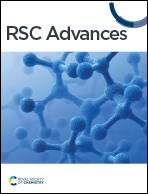Suppression of intrinsic thermal conductivity in Sr1−xGdxTiO3 ceramics via phonon-point defect scattering for enhanced thermoelectric application
Abstract
A substantial reduction in the thermal conductivity for strontium titanate (ABO3) perovskite structure was realized for the A-site substitution of gadolinium (rare earth element) in SrTiO3 ceramics. The effect of Gd3+ substitution on the structure, composition, and thermoelectric properties of SrTiO3 was investigated. The substitution of Gd3+ in the SrTiO3 matrix resulted in the minimalization of thermal conductivity. The thermal conductivity followed a similar trend as that of thermal diffusivity, but specific heat capacity exhibited a non-monotonic trend. The thermal conductivity is reduced to 1.05 W m−1 K−1 for the minimal substitutional composition (Sr0.99Gd0.01TiO3) which is 30% less than that of SrTiO3 at 303 K. The variation in the ionic radii and atomic mass of the heavier rare earth Gd3+ substituted over Sr2+ resulted in the reduction of thermal conductivity of SGTO ceramics caused by the corresponding boundary scattering at low temperatures and temperature-independent phonon-impurity scattering at high temperatures.



 Please wait while we load your content...
Please wait while we load your content...